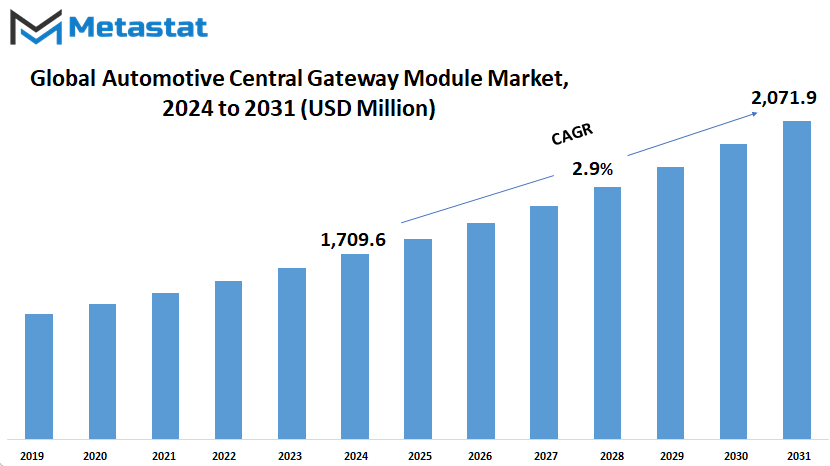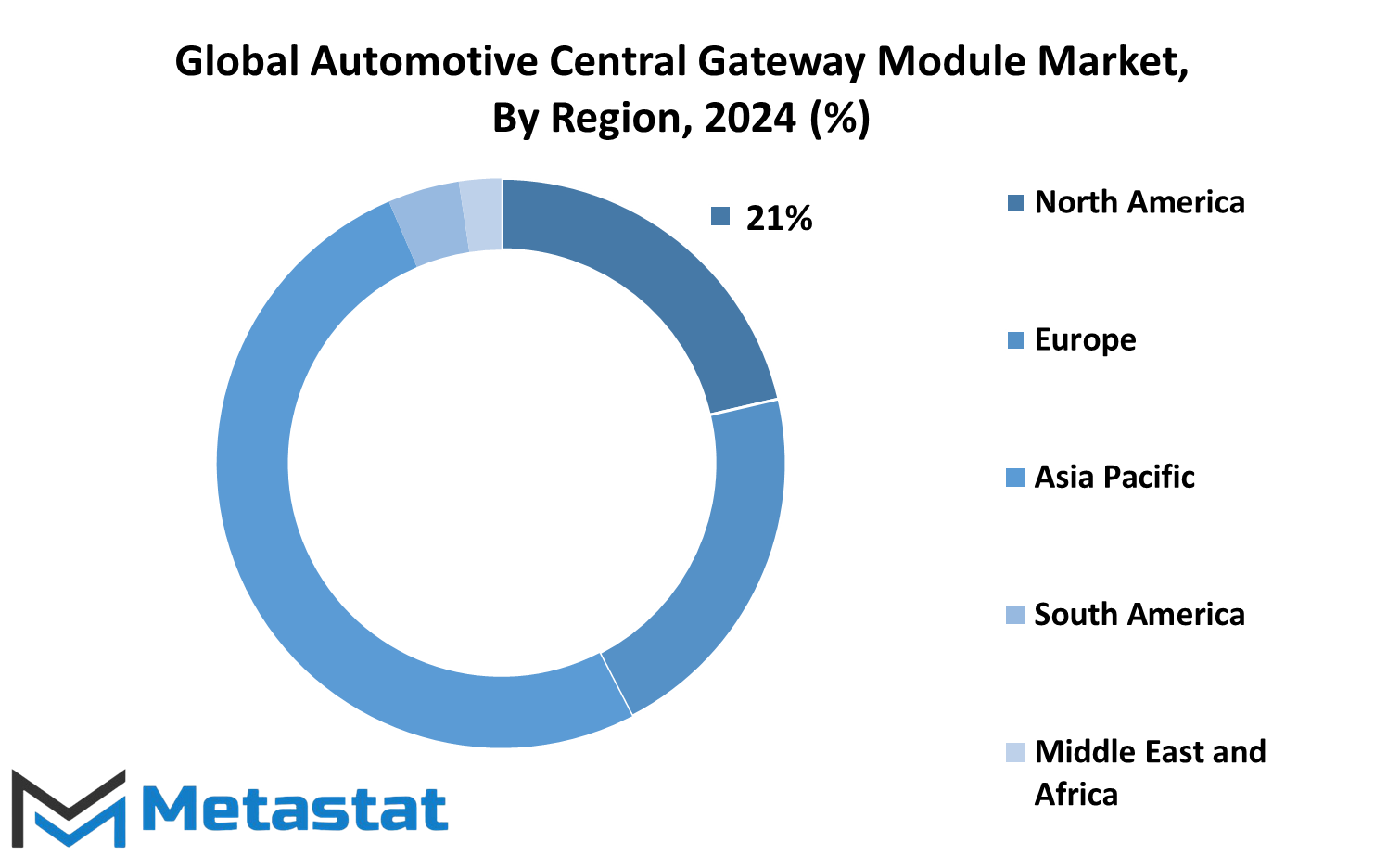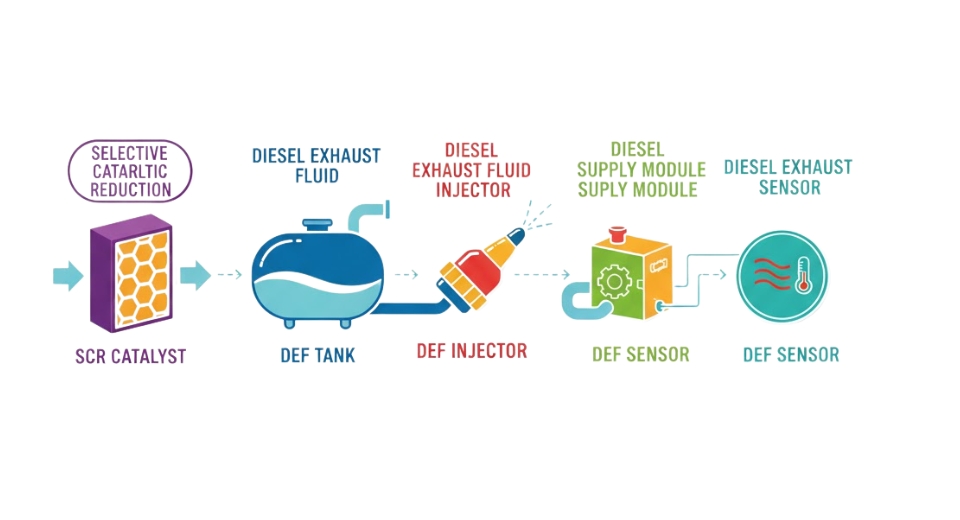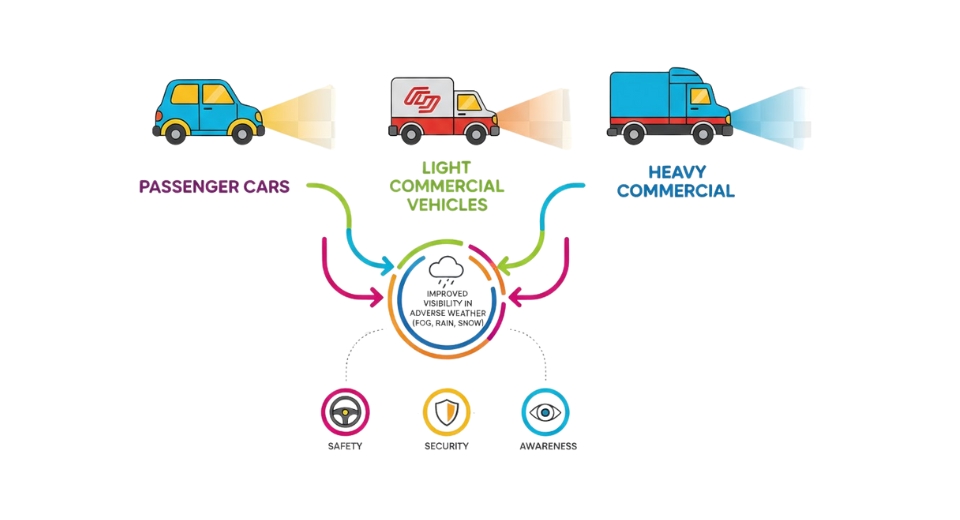MARKET OVERVIEW
The Global Automotive Central Gateway Module market is an integral part within the automobile industry, governing all contemporary vehicle functionality. Positioned at the center of the vehicular network, the central gateway module has placed itself in the middle to act as the nerve center for in-vehicle architecture, facilitating coherent communications among various electronic control units (ECUs) which form an architecture of the vehicle. This module works just like a gateway, facilitating the exchange of data and issuance of various commands within the vehicle, which has an intricate network of sensors, actuators, and ECUs. In a recent automotive environment, replete with advanced driver assistance systems, infotainment solutions, and connectivity features, there was a need for the implementation of CGMs. Such modules contribute much to the integration of various automotive systems but also provide vehicle performance, safety, and user experience.
The Automotive Central Gateway Module has a central role in the collection of data from various, geographically dispersed ECUs within the vehicle and subsequently processes this information. In aggregating information related to engine management, transmission control, chassis dynamics, and other such areas, the CGM acts as a central intelligence hub that forms decisions efficiently and coordinates system activities in an effective manner. Other than smoothening vehicle operations, this kind of centralized approach has much to do with improved diagnostics, which provide for proactive maintenance or troubleshooting of the vehicle.
The Global Automotive Central Gateway Module market also sees remarkable developments on the inclusion of technologies such as Artificial Intelligence, Machine Learning, and Cybersecurity protocols. manufactuers are applying AI algorithms in optimizing data processing and predictive analysis to let CGM forecast vehicle behavior and adjust to any given dynamic driving condition, even avoid potential safety hazards in real-time.
Moreover, connected car technologies and autonomous driving systems have further accelerated the role of CGMs. These modules form one of the core enablers of next-generation vehicle-to-everything communication, V2X, which enables seamless interaction with external infrastructure, other vehicles, and pedestrians. Working as a channel to exchange data in this nascent smart mobility ecosystem, CGMs are playing a vital role in bringing about interlinked transportation networks: the confluence of transportation networks where safety, efficiency, and sustainability converge in perfect harmony.
Besides technological innovation, the Global Automotive Central Gateway Module market is also driven by the regulatory mandates and industry standards ruling vehicle electronics and cybersecurity. It means that manufacturers have to follow strict guidelines in order to protect the vehicle systems against cyber-attacks and guarantee privacy for the occupants inside the vehicle. To this end, CGM designs enshrine robust security features in the design, such as encryption protocols, intrusion detection systems, and secure boot mechanisms that reduce the potential risk of being victims of cyber-attacks or unauthorized access.
The Global Automotive Central Gateway Module market represents a dynamic landscape that is being driven by technological innovation, regulatory compliance, and changing consumer expectations. As vehicles increasingly evolve into being interconnected and intelligent devices, the role of CGMs will lie at the heart of enabling seamless communication, improving vehicle performance, and delivering a safe and immersive driving experience.
Global Automotive Central Gateway Module market is estimated to reach $2,071.9 Million by 2031; growing at a CAGR of 2.9% from 2024 to 2031.

GROWTH FACTORS
The following factors drive the growth of the Global Automotive Central Gateway Module market. Increasingly sophisticated in-vehicle electronics and connectivity features are the principal drivers for this market. As vehicles turn more complex, the requirement for a centralized control unit such as the central gateway module grows at a very fast pace. These modules work as one-stop centralized units for managing various functions within the vehicle and ensure smooth communication between different systems.
Another reason for the market growth is the raising integration of advanced driver assistance systems and infotainment systems. All these advanced features need a strong communication infrastructure to operate. Hence, demand for central gateway modules rises to fulfill the required connectivity and compatibility.
However, there are also some challenges that need to be addressed in the market. They include the cost pressure from automobile manufacturers, especially for low-budget vehicle segments, which further can increase the overall cost of manufacturing if a centralized gateway module is introduced, and may result in some companies not wanting to use these technologies.
Other growth inhibiting factors in the market include older vehicle system compatibility issues and interoperability. Most of the current vehicles are installed with older electronic systems, which are not as easy to integrate with the modern central gateway module. Manufacturers, therefore, find it very difficult to integrate such modules into their prevailing vehicle architectures seamlessly.
Besides, amidst the challenges, growth opportunities are offered by the market. Development of standardized communication protocols and interfaces for the central gateway module may resolve most incompatibility issues. Common standards set by manufacturers give them easier integration and better compatibility with different vehicle platforms and manufacturers. This would thus make the integration process smoother and increase the market reach of central gateway modules.
The rising complexity of vehicle electronics, in conjunction with advanced driver assistance and infotainment systems, drives the Global Automotive Central Gateway Module market. Cost constraints and incompatibility issues pose a challenge, while the development of standardized protocols presents an opportunity in the future. Central gateway modules will become prominent for ensuring proper communication and connectivity within a vehicle in an evolving automotive industry.
MARKET SEGMENTATION
By Type
The Global Automotive Central Gateway Module market is rapidly changing with the demand from the vehicle becoming connected and intelligent. This market is going to show tremendous growth due to the creation of advanced technologies in the automotive section and aspirational needs for smart transport solutions. Based on the type, the market segments into Ethernet Central Gateway Module, CAN Central Gateway Module, LIN Central Gateway Module, FlexRay.
Ethernet Central Gateway Modules play a key role in managing high-speed data transfer between in-vehicle systems. Against the backdrop of growing adoption of advanced infotainment, navigation, and driver assistance systems in vehicles, demand for more robust data communication networks inside the vehicle is gathering momentum. Ethernet modules do this through the provision of a high-bandwidth, low-latency communication backbone that ensures the perfect integration and smooth functioning of different vehicle functions.
The demand for CAN Central Gateway Modules in the automotive industry remains unabated. They realize the communication process between different electronic control units (ECUs) within an automotive vehicle. CAN modules have proven to be very reliable and are real-time capable; hence, they are suitable for use in critical applications like engine management systems, braking systems, and powertrain control. With increasing complexity of automotive systems, their role remains indispensable in assuring stable and efficient communication.
It is normally used for LIN Central Gateway Modules in lower speed tasks of vehicle communications, such as climate control, seat adjustments, lighting, and so forth. With their relatively low speed, LIN modules, however, can have cost-effective solutions toward the total efficiency and functionality of the vehicle. Their role is expected to further increase with more features added into entry-level and mid-range vehicles.
The FlexRay Central Gateways Modules come with high-speed and deterministic data transmission, hence finding operation in applications that require precise and reliable data communication. The FlexRay modules find very frequent applications in ADAS or any other autonomous driving technologies where data interchange in real-time is indispensable. As the automation level within vehicles continues to grow, it is expected that FlexRay module demand will also grow in line with the pursuit of safe and efficient autonomous vehicle development.
In the future, also, with the continuous improvement in technology, the prospects for the Global Automotive Central Gateway Module market will turn out to be very inspiring. Next-generation innovations of automobiles would call for advanced in-vehicle communication networks. Given the continued development in vehicle connectivity, the requirement for a dependable and productive gateway module will surge, thereby boosting this market. Different applications of Ethernet, CAN, LIN, and FlexRay modules are going to decide the future course of the automotive industry, making vehicles smarter, safer, and more connected than ever.
By Application
The global automotive central gateway module market is segmented based on its application, including Powertrain Control, Body Control, Infotainment System, Advanced Driver Assistance Systems (ADAS), and Others.
Powertrain Control: This comprises all electronic systems that control and govern the functioning of an automobile's engine and its transmission. These systems have a vital role in optimizing the vehicle's performance, fuel efficiency, and emission control.
Body Control includes all the electronic components responsible for various functions in the vehicle's body, such as lighting, climate control, and security systems, which work smoothly to provide convenience to the user.
Infotainment System technology providing entertainment, communication, and navigation inside the vehicle. The interfaces include multimedia, connectivity options, and navigation systems to make the inside car experience much better.
ADAS (Advanced Driver Assistance Systems) are a collection of electronic systems put in place to assist the driver during the driving process and improve safety. Examples of ADAS features include adaptive cruise control, lane-keeping assistance, and automatic emergency braking.
The "Others" category holds other applications of the automotive central gateway module that cannot be put into the above-mentioned categories. These include emerging technologies, specialized functions, or custom applications for vehicle models and market segments.
Each of these application segments plays an important role in the total functioning and performance of today's automobiles. The automotive central gateway module is a central module for communication and data exchange between the different electronic components and systems of a vehicle.
If the market is segmented based on the application, manufacturers and suppliers cannot only be aware of but also meet the requirements of the respective automotive segment. The segmentation at this level also allows more effective marketing techniques and product development to suit the various needs of the customers connected with the industry.
The global automotive central gateway module market is segmented by various application categories such as Powertrain Control, Body Control, Infotainment System, Advanced Driver Assistance Systems (ADAS), and Others. All of these represent different aspects of vehicle functionality and technology, therefore showing the centrality of the central gateway module in the facilitation of communication or integration within modern automobiles.
By End User An important market under the overall market for vehicles and electronic systems, the global market for automotive central gateway modules, is poised to be in an uphill growth trail in the years ahead. The gateway module becomes the central piece, orchestrating communication between all the different electronic systems in a vehicle. With increased automotive technology requirements now needing up-to-date systems that are more efficient and seamlessly interlinked, the market is on a rise.
The next potential opportunity for global vehicle central gateway module market is expected to shape amidst the increasing incorporation of systems driven by ADAS and autonomous driving technologies. These technologies call for seamless communication of myriads of sensors, cameras, and control units, which will be orchestrated by the central gateway module. If there were steps further in terms of self-driving vehicles, this would only call for the need for robust and reliable gateway modules to power that change.
Furthermore, moving ahead, the automotive industry is gradually transitioning to electric vehicles, again complicating the electronic system accordingly. The central gateway module will be significant for communication between the battery management system and other powertrain control and electronic components, ensuring energy-efficient and safe operation; it will therefore lead to increased demand for advanced gateway modules.
In regard to end users, the market will rise, subdivided into passenger vehicles and commercial vehicles. For the passenger vehicles, these will be advanced products for designing the infotainment, navigation, and connectivity features in the most intuitive manner for the users. The consumers are urging the need for their vehicles to be smart, and it is against this backdrop that these features are integrated with the best modules.
On the other hand, the commercial vehicle segment will be focused on reliability and efficiency of communication systems. Commercial vehicles such as trucks and buses might significantly benefit from advanced gateway modules that will feature well-flowing telematics systems, fleet management, and vehicle diagnostics. This is very important for logistics and transport companies that heavily depend on vehicles being reliable and efficient in order to sustain their operations.
The global automotive central gateway module market would also surge because of the rise in regulatory needs around the globe. With stricter regulations based on vehicle safety and emissions being mandated by governments worldwide, it would require even more advanced electronic systems. Central gateway modules will be playing a key role in making vehicles conform to these regulations, further boosting the market.
REGIONAL ANALYSIS
One of the key markets growing much in its expansion is the global Automotive Central Gateway Module market. It also shows the presence of different regions in the market, including North America, Europe, Asia-Pacific, South America, and the Middle East & Africa.
In North America, key leaders are the United States, Canada, and Mexico. The United States leads the region with a highly developed market in the automotive sector and a rising demand for connected cars. Growing interest in the field of automotive technology in Canada and a fast-paced developing manufacturing sector in Mexico further add to the market strength.
Europe is another critical player, known for having a strong heritage in the automotive sector. The UK, Germany, France, and Italy come to the forefront and have well-established industries in the automotive sector. Germany really is very strong because of its innovative technologies regarding the automotive sector. France and Italy are pretty much on board with their rich heritage in the industry and high market presence. Other parts of Europe have also shown significant contributions toward the market growth.
Essentially, rapid growth is witnessed in the region from countries like India, China, Japan, and South Korea. The world's biggest automotive market is in China, which itself boosts growth. The growth in the region is also driven by the technological advancement and robustness in the automotive industry of Japan and South Korea. The increasing automotive sector and rising interest in technology make India one of the countries driving regional market dynamics. The remaining countries of Asia-Pacific also fuel market growth.
In South America, the two major players are Brazil and Argentina. The large automotive industry in Brazil and the growing market of Argentina make the region important. In the remaining part of South America, there is also a contribution to the development of the market.
Also, the Middle East & Africa region—GCC countries, Egypt, and South Africa—is giving back to the growth of the market. The GCC countries themselves are growth markets due to their increasing interest in automotive technology. Egypt and South Africa, with their developing automotive sectors, also add to the market dynamics of the region. The rest of Middle East & Africa is also contributing to the expansion of the market.
The global automotive central gateway module market looks ahead for further growth. With advancing technology and connected vehicles still coming to the forefront of the market, all regions of the world would further support the development of this market. North America, Europe, Asia-Pacific, South America, and Middle East & Africa are regions that will further contribute to the growth of the market. Each region has its strength and peculiar dynamics. During the forecast period, the global automotive central gateway module market is expeditious and has promising growth opportunities from all major regions.

COMPETITIVE PLAYERS
The global Automotive Central Gateway Module market is poised to grow at a substantial rate, driven by technological developments in this area and growing demand for connected cars. In a nutshell, the central gateway module serves as a central node for vehicle communication networks, providing the core of data transfer between different ECUs. This module will enable the integration of all systems, enhancing functionality and efficiency in today's vehicles. These modules will be necessary for creating smarter and more connected cars in the future, so their importance is only going to increase as automotive technology evolves. In this respect, it would probably mean that the market for automotive central gateway modules will see fast expansion in the future.
The rapid development of EV and autonomous driving technologies should make robust and efficient communication networks urgently needed within a vehicle. These modules will become necessary in managing these complex data flows, from processing sensor data to real-time decision-making algorithms that will be required for autonomous driving. Turning around, the development and fine-tuning of central gateway modules will become a prime concern for many automotive manufacturers and technology providers. Several players drive innovation and market share within this competitive landscape. The companies that are leading from the front include Aptiv PLC and Continental, using their experience in automotive technology to engineer state-of-the-art gateway modules.
Delphi Automotive and Denso are among the big contributors, well known for the quality of their products and the ability to innovate. Other companies making big pushes within the market include Fescaro Co. Ltd., HiRain Technologies, and Hitachi Astemo with their state-of-the-art solutions. Other key participants include Infineon Technologies and Lear Corporation, armed with semiconductor technologies and electronic system expertise, while Magna International Inc. and NetModule are far advanced in the area of new technology integration into their modules. NXP Semiconductors, Omron, and Robert Bosch innovate at the forefront with module development for state-of-the-art connectivity and automation. Other key vendors in the market include Sumitomo Electric Industries, Ltd., Texas Instruments, and ZF Friedrichshafen AG. Each of them contributes differently to the market.
Their contribution is vital in developing modules capable of sustaining loads of a modern vehicle. These companies compete not only in terms of the quality of their products but also in terms of innovation and adaptability to the new scenario in the automotive sector. With a highly networked and self-automated future ahead for the automotive industry, the role of the Automotive Central Gateway Module will become even more crucial. Developmental work in innovation will be driven by these players in the field, empowering vehicle communication network development to create next-generation vehicles safer, efficient, and connected than ever.
Automotive Central Gateway Module Market Key Segments:
By Type
- Ethernet Central Gateway Module
- CAN Central Gateway Module
- LIN Central Gateway Module
- FlexRay
By Application
- Powertrain Control
- Body Control
- Infotainment System
- Advanced Driver Assistance Systems (ADAS)
- Others
By End User
- Passenger Vehicles
- Commercial Vehicles
Key Global Automotive Central Gateway Module Industry Players
- Aptiv PLC
- Continental
- Delphi Automotive
- Denso
- Fescaro Co.Ltd.
- HiRain Technologies
- Hitachi Astemo
- Infineon Technologies
- Lear Corporation
- Magna International Inc
- NetModule
- NXP Semiconductors
- Omron
- Robert Bosch
- Sumitomo Electric Industries, Ltd
WHAT REPORT PROVIDES
- Full in-depth analysis of the parent Industry
- Important changes in market and its dynamics
- Segmentation details of the market
- Former, on-going, and projected market analysis in terms of volume and value
- Assessment of niche industry developments
- Market share analysis
- Key strategies of major players
- Emerging segments and regional growth potential








 US: +1 3023308252
US: +1 3023308252






